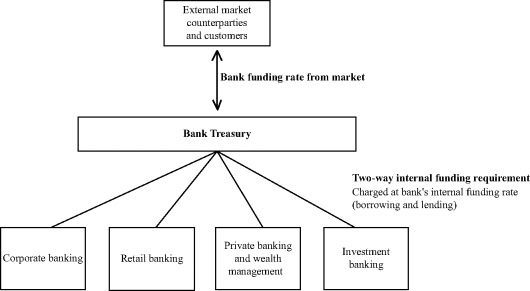Chapter 15
Internal Funds Pricing Policy
When describing the funding arrangements in place at a bank, the basic organisation structure involves a central Treasury function that manages all borrowing and lending requirements for the bank at an aggregate level, dealing with the external market, and acts as the internal counterparty for the funding requirements of all the bank's business lines. This is illustrated at Figure 15.1. Centralising the funding arrangement removes interest-rate risk and basis risk at the business line level, and also eliminates the funding mismatch risk at the customer face. These risks are instead centralised and managed by the Treasury desk. The terms under which the Treasury desk lends to the internal business lines has always been recognised to be an important part of the liquidity and funding management policy of the bank. This is for a number of reasons, the most important being that it is a key driver of the capital allocation decision. For efficient and disciplined business decision-making therefore, a bank's internal funding policy, known variously as funds transfer pricing, term liquidity premium or simply transfer pricing, must be both rigorous and realistic.
Figure 15.1 Bank funding structure.

This is not a new concept; for instance, in the author's earlier book Bank Asset and Liability Management there is a discussion on the alternative approaches ...

